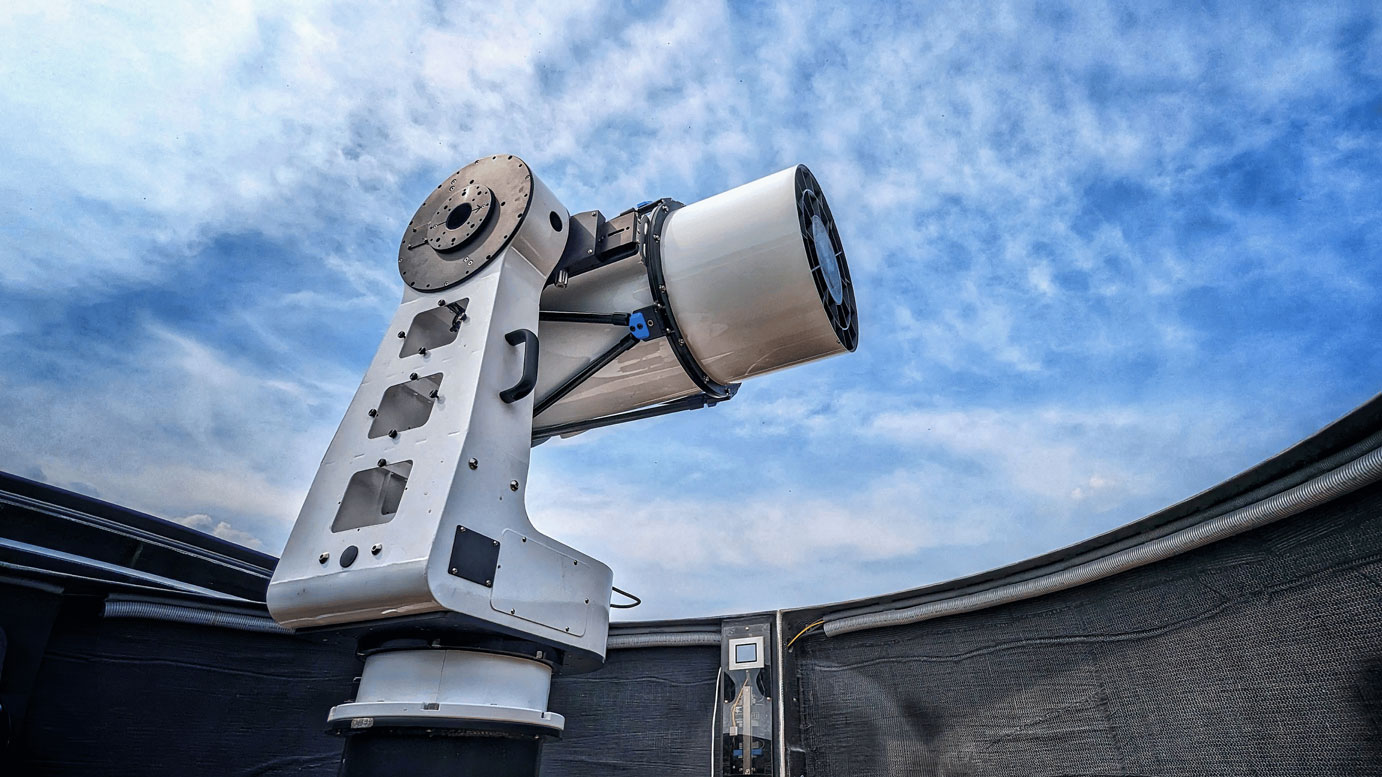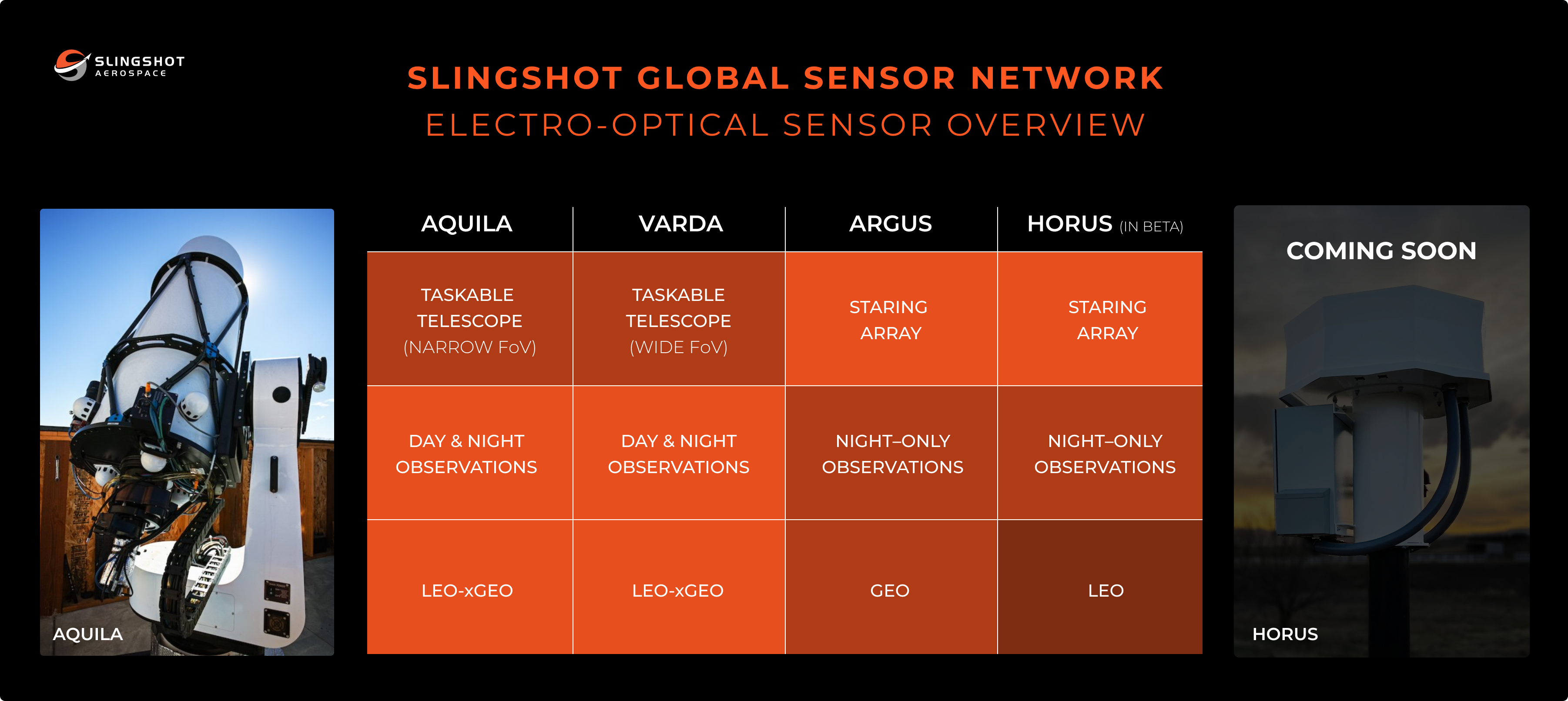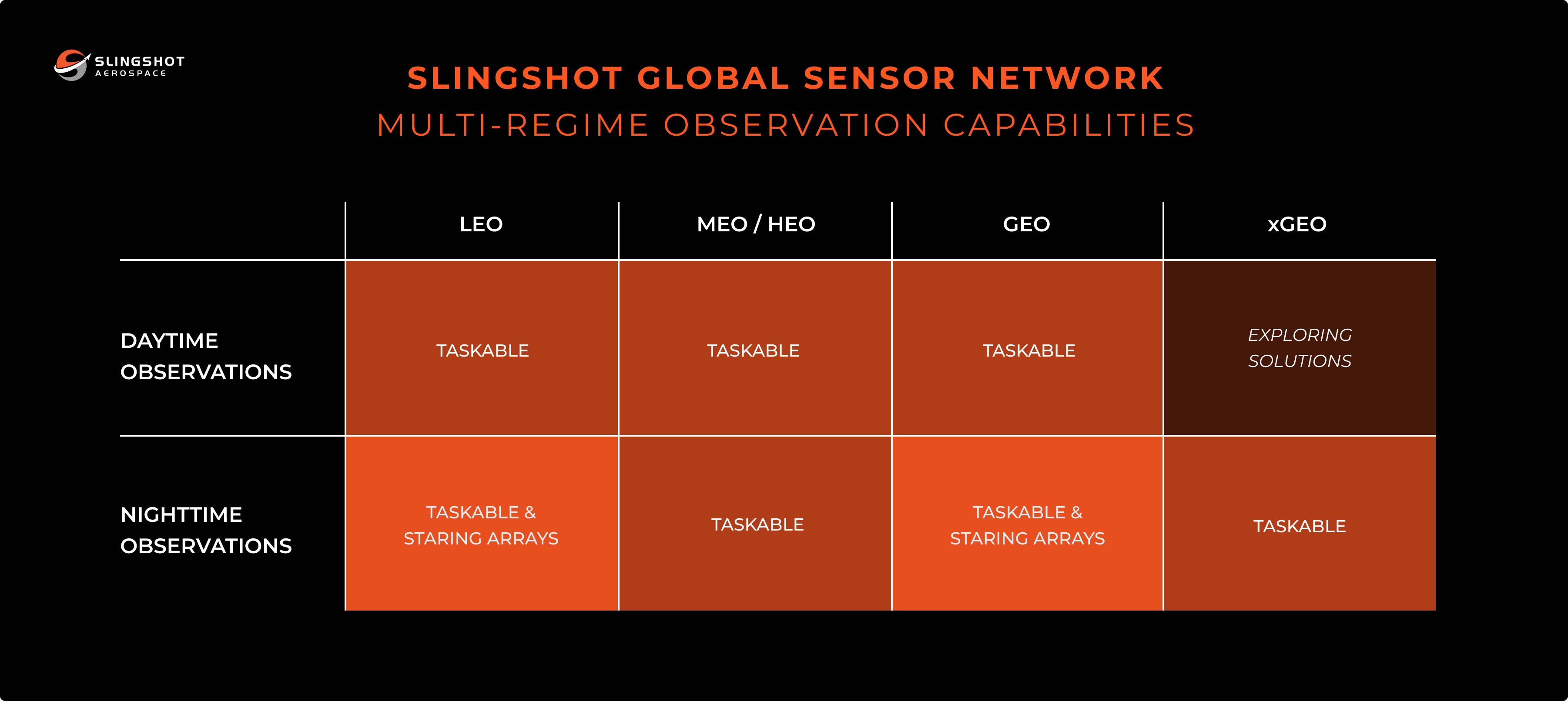
Safeguarding the Final Frontier: Optical Sensors for Persistent Space Domain Awareness
The Slingshot Global Sensor Network is a collection of over 150 optical sensors at 20+ global sites (with more coming online this year) that provide 24/7 tracking and monitoring of space objects from LEO to GEO and beyond.
Current State of Space Domain Awareness
There were less than 1,000 active spacecraft in orbit in 20101; there are over 8,000 active spacecraft in orbit today2; and projections point upwards of 100,000 active spacecraft in orbit by 20303. In this period of exponential growth, space domain awareness (SDA) will remain the foundation for keeping these spacecraft and humanity’s near-Earth space environment safe and sustainable. But the SDA problem set is growing in tandem: unexpected payload separations and maneuvers threaten situational awareness in low Earth orbit (LEO), rendezvous and proximity operations (RPOs) demand vigilance in geostationary Earth orbit (GEO), and interest in new horizons is picking up in cislunar or “beyond GEO” (xGEO) orbits.
Given these changes, it’s no surprise that satellite operators and space agencies alike are seeking multiple tools, or sensing modalities, to support their diverse mission needs across orbital regimes.
Ground-based optical sensors like the Slingshot Global Sensor Network bring a unique set of capabilities and insights to the space/satellite operator’s toolbelt, augment (or even replace) existing modalities, and help bring clarity to an increasingly complex orbital operating environment.
Understanding Optical Sensor Systems
Ground-based electro-optical (EO) sensors collect astrometric and photometric data by detecting and measuring light signals reflected by objects in space. The Slingshot Global Sensor Network is a collection of over 150 optical sensors at 20+ global sites (with more coming online this year) that provide 24/7 tracking and monitoring of space objects from LEO to GEO and beyond.
Slingshot’s network consists of multiple proprietary optical sensor types including both taskable gimbaled telescopes and persistent staring arrays – all of which provide unique capabilities and work together to create a network that provides persistent day/night satellite tracking. These sensors produce high-accuracy optical measurements (at single-digit to sub-arcsecond astrometric accuracies) – which when processed through Slingshot’s proprietary software enable industry-leading uncorrelated track (UCT) resolution, orbit determination (OD), and maneuver detection (MD).

Specifically, Slingshot’s Tasking, Collection, Processing, Exploitation, and Dissemination (TCPED) pipeline turns this network of telescopes into a set of priority-scheduled and persistent data collectors – producing low-latency optical observations and actionable insights for satellite operators and space agencies.
Tasking
Sensor optimization algorithms use tracking prioritization inputs from Slingshot’s orbital analysts and customers to task each telescope in the Slingshot Global Sensor Network – ensuring that the network is appropriately scheduled to satisfy the customers’ varied mission needs and use cases. On-demand tasking requests from our customers are seamlessly integrated with automated sensor scheduling.
Collection
On-site servers autonomously monitor weather conditions, control roof/dome enclosures, and execute tasking through complex interactions with sensor hardware. High-accuracy pointing models accurately steer gimbaled telescopes to ‘rate-track’ satellites even at the lowest LEO altitudes. Visible, near-infrared, and shortwave infrared sensors collect sequences of time-tagged, high data-rate images at exposure cadences varying from less than 0.1Hz to above 100Hz.
Processing
Patented, automated image processing algorithms reduce high-data-rate imagery streams into low-data-rate detections with line-of-sight and brightness measurements. These measurements are then calibrated against the latest star catalogs to produce high-accuracy astrometric and photometric observations.
Streams of observations from each sensor are grouped into “sensor tracks.” Slingshot’s Multiple Frame Assignment Space Tracker (MFAST) then compares these sensor tracks with Slingshot’s existing orbit state estimate database and either correlates and extends an existing orbit state or, when enough data is available, identifies a new object through initial orbit determination (IOD).
Exploitation
Once the raw data from the Slingshot Global Sensor Network has been calibrated, correlated (associated to known objects), and fused together to form updated orbital states, Slingshot’s indications and warning (I&W) data analytics components automatically produce alerts against maneuver detections, photometric change detections, conjunction reports, reachability analytics for assessing potential on-orbit threats, and other critical insights.
Dissemination
Slingshot’s data products are disseminated in minutes from collection for use by government agencies and commercial operators servicing a range of missions. Space operations involve the integration of numerous systems — both terrestrial and spaceborne, civilian and military, domestic and international — and the ability to share and use data across these systems is key to our customers' success.
Overcoming Traditional Optical Tracking Challenges
LEO Tracking at Scale
Slingshot's sensors are already tracking high-priority objects in Low Earth Orbit (LEO), but the need for large-scale LEO tracking grows alongside the LEO population. As such, Slingshot has developed the first uncued commercial optical fence that can simultaneously detect and track all transiting LEO objects of cubesat size or larger. Unlike gimbaled optical systems and commercial radars that use cues to steer optics or beams, each optical fence system persistently monitors the entire horizon. This first-of-its-kind highly-scalable system enables a two-tiered approach to LEO space surveillance:
- Slingshot’s optical fence systems track the majority of LEO payloads in a completely uncued fashion (e.g., not relying on prior information from internal or external sources). This persistent modality enables tracking through maneuvers, separations, breakups, Launch and Early Orbit Phase (LEOP) operations, and reentries while also providing regular photometric signatures for exploitation.
- Slingshot’s gimbaled telescope systems monitor high-priority satellites. These systems detect smaller objects, operate in local daytime and nighttime, allow the network to achieve higher revisit rates, and collect more information on each satellite pass to further increase orbital state estimate accuracy.
Learn more about our LEO-focused Slingshot Global Sensor Network expansion here.
Daytime Observation
Daylight-capable optical systems provide, on average, 400% more observable LEO passes than night-only equivalents4. This drastic improvement to observation frequency enhances the value of each daytime-equipped sensor and extends the window of viewability each day – improving the network's ability to maintain custody of objects with more regular observations and cataloging.
Furthermore, Slingshot’s patented daytime optical capability provides a passive EO option for tracking LEO objects in heavily populated sun-synchronous orbits (SSO). Nighttime-only optical systems can only monitor LEO in short windows near dawn and dusk when the satellites are still sunlit. Objects in noon/midnight SSO tend to cross the day/night terminator near the north/south poles, where ground-based systems are challenging to deploy. Likewise, objects in dawn/dusk SSOs ride the terminator, often preventing observation from ground-based sites in astronomical dark conditions. In contrast, Slingshot’s daytime-capable systems can regularly observe satellites in these SSO configurations.
Weather-Related Outages
Slingshot’s 150+ sensors at 20+ sites globally create a resilient, distributed network that mitigates weather outages and provides redundant observation opportunities to ensure persistent tracking and custody. Each Slingshot Global Sensor Network site is carefully chosen following a detailed analysis of both local historical weather patterns and weather correlations with neighboring sensor sites to maximize network viewing regularity. When local weather outages occur, Slingshot’s sensor resource optimization software rapidly reallocates tasking across the network to other available sensors.
Advantages of Slingshot’s Global Sensor Network
Slingshot’s ground-based day/night optical sensors have a number of key advantages over other SDA sensing modalities which make them an ideal candidate for contributing to a more complete picture of the space domain.
Improved Custody Through High Revisit Rates
High revisit rates (the time between successive observed passes on the same satellite) are core to the mission of space domain awareness and represent a critical component in space object custody. Low revisit rates - long durations between successive pass observations - represent periodic blind spots and impede the goal of building a comprehensive view of the orbital operating environment.
Historically, optical sensor networks with a small number of sites have struggled to deliver high revisit rates due to sensor capacity constraints, weather, and limited nighttime viewing windows. However, the Slingshot Global Sensor Network combines several unique technical attributes to create a mesh network of sensors that provide as good or better revisit rates (and custody), than other sensing modalities, in addition to the many advantages of photometric information:
- Distributed Global Network: Slingshot’s network of 20+ strategically selected global sites increases the total opportunities for observations each day. The Slingshot Global Sensor Network will continue to expand throughout 2023, further improving revisit rates and custody.
- Patented Daytime Observation Capabilities: Slingshot is the first commercial optical data provider capable of daytime satellite observation from LEO to GEO. Slingshot’s patented daytime sensors allow for 5x the number of observation opportunities compared to night-only systems – increasing the length of daily observation windows for each site and dramatically adding to the total number of observations possible across the network each day.
- Multiple Sensor Types: Slingshot’s multiple distinct optical sensor types include both gimbaled telescopes and ultra-wide-field-of-view staring arrays. The staring arrays provide uncued observation of all detectable objects in their field of view, while gimbaled systems provide higher detectability and daytime operation. This combination provides a natural tipping/cueing synergy to increase revisit rates across the network.
For more details on how Slingshot benchmarks its revisit rates, please email info@slingshot.space and you will be connected with a member of our Slingshot Global Sensor Network team.
Superior LEO State Estimate Accuracy Through ‘Dirt-to-Dirt’ Tracking
Gimbaled telescope systems have a dynamic field of regard which allows Slingshot to track a given satellite from horizon to horizon (a.k.a. dirt-to-dirt) during each overhead pass, thereby improving orbital state accuracy beyond what is possible from a fixed field-of-view. The majority of LEO satellite passes over the Slingshot Global Sensor Network exceed 1-2 minutes in duration, and Slingshot’s MFAST software uses these observations to rapidly generate precise orbital state estimates. The figure below shows how the typical position error of a 600 km altitude LEO object is reduced as the duration of the tracked pass increases. Long passes also improve the accuracy of derivative state terms (e.g., velocity) enabling higher-fidelity orbital propagations.

Actionable Insights Through Photometric Observations
Photometric observations (brightness measurements) are only produced by optical sensors and can be used to detect changes in certain kinds of satellite behavior (such as attitude configuration) or to characterize certain aspects of a satellite’s structure or orientation. Slingshot has developed a proprietary AI/ML-based photometry prediction model that autonomously predicts the apparent magnitude (e.g., visual magnitude or brightness) of a satellite, and in turn, compares it with the observed apparent magnitude to identify changes to the satellite’s photometric signature.
Identifying photometric changes enables rapid identification of attitude adjustments, changes in attitude stabilization modes, thruster activity, or other on-orbit anomalies that may not necessarily be observable through kinematic (e.g., orbital state) data alone. Photometric data can also aid in object identification. For example, in the case of the recent ViaSat-3 launch aboard SpaceX’s Falcon 9 , Slingshot used its photometric observations to rapidly differentiate between the payload fairing and the spacecraft, enabling identification and orbit determination of the spacecraft before it was publicly cataloged.
Multi-Regime Tracking
Slingshot’s multiple optical sensor types work together to provide multi-regime coverage from LEO to xGEO. This is especially advantageous for space agencies seeking insights across regimes and for the growing number of commercial operators who own and/or operate satellites in more than one orbital regime. Multi-regime tracking also allows for the tracking of an object between launch and its final orbit, regardless of its initial deployment and destination orbit.
During a developing space event, Slingshot’s adaptable, multi-regime capability allows the Slingshot Global Sensor Network to quickly pivot sensor support from one orbital regime to another. If an urgent need arises for more data in LEO, MEO, GEO, or even xGEO, Slingshot can rapidly reallocate Slingshot Global Sensor Network resources to focus on the specific objects or orbits of interest.

Ease of Deployment and Network Resiliency
Passive EO sensors require relatively few resources (land, power, and capital) to deploy compared to active radar systems and do not require regulatory approval to operate. Low power requirements are a major advantage of optical systems, making it possible to deploy sensors in regions with limited infrastructure and allowing for the rapid development of large-scale, distributed optical networks.
These unique operational requirements have allowed Slingshot to rapidly deploy sensors to 20+ sites globally, with several more coming online this year. Slingshot’s distributed network has produced over 500 million observations to date that have been vetted and validated by multiple external organizations, and Slingshot Global Sensor Network data products are used operationally by a myriad of government and commercial entities around the globe.
Autonomous and Passive Optical Detection Capabilities
The passive optical measurements derived from Slingshot's global autonomous sensor network introduce an additional level of resilience against methods employed by non-cooperative satellites to modify or obstruct radar and passive radio frequency (RF) observations. Our optical detection capabilities eliminate the possibility of non-cooperative satellite operators predicting or evading sensing opportunities. With active sensing like radar, a satellite could sense when energy is being emitted to track it (if equipped to do so), and could therefore predict future opportunities to maneuver unseen. Additionally, known passive-RF sites can be evaded through temporarily pausing RF transmission. A robust proliferated passive optical network can operate undetected and reflected sunlight signals cannot be avoided.
Slingshot’s SDA Solutions
Slingshot Vantage is the world’s only day and night LEO-to-GEO optical tracking and monitoring service – driving mission safety and mission optimization for satellite operators with 24/7 insights from the Slingshot Global Sensor Network.
The Slingshot Global Sensor Network currently distributes millions of observations per month to government agencies and commercial customers around the world to provide mission-critical space domain awareness insights – whether improving orbit determination, reducing collision uncertainty, safely moving to a new orbital slot, or quickly establishing post-launch contact.
We’re proud to have some of the world’s leading experts in optical sensing, data fusion, artificial intelligence, and machine learning on our team tackling the evolving needs of the market. Let’s work together to help improve your orbital operations and continue improving space domain awareness for all.
See Slingshot Vantage in Action:
- Inmarsat Uses Slingshot’s Global Sensor Network Data for Critical Space Maneuvers
- Slingshot Is First to Catalog ViaSat-3 After SpaceX Launch
- Slingshot Contributes to the Center for Strategic and International Studies (CSIS)'s Space Threat Assessment Report
Email info@slingshot.space to learn more about Slingshot’s SDA capabilities.